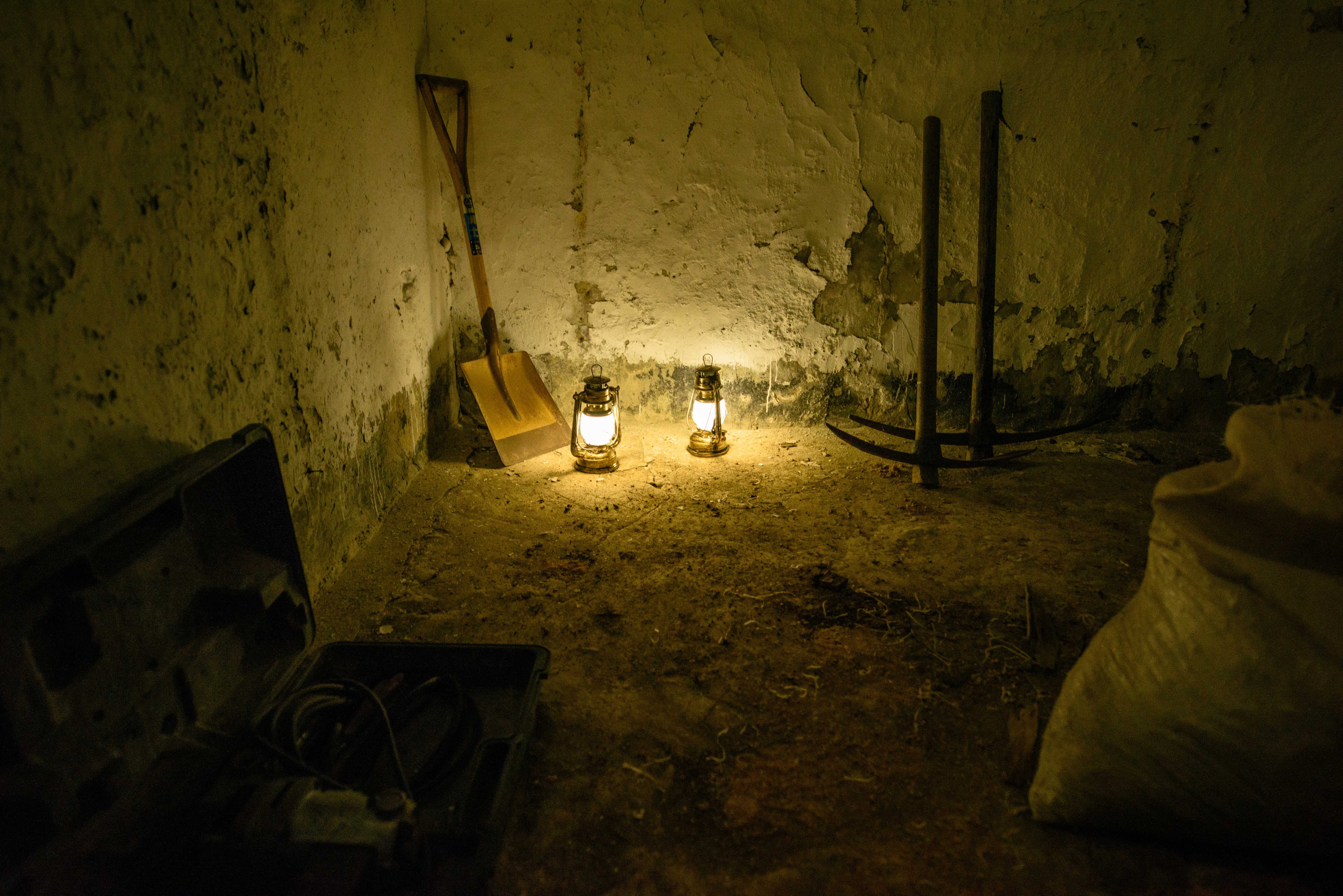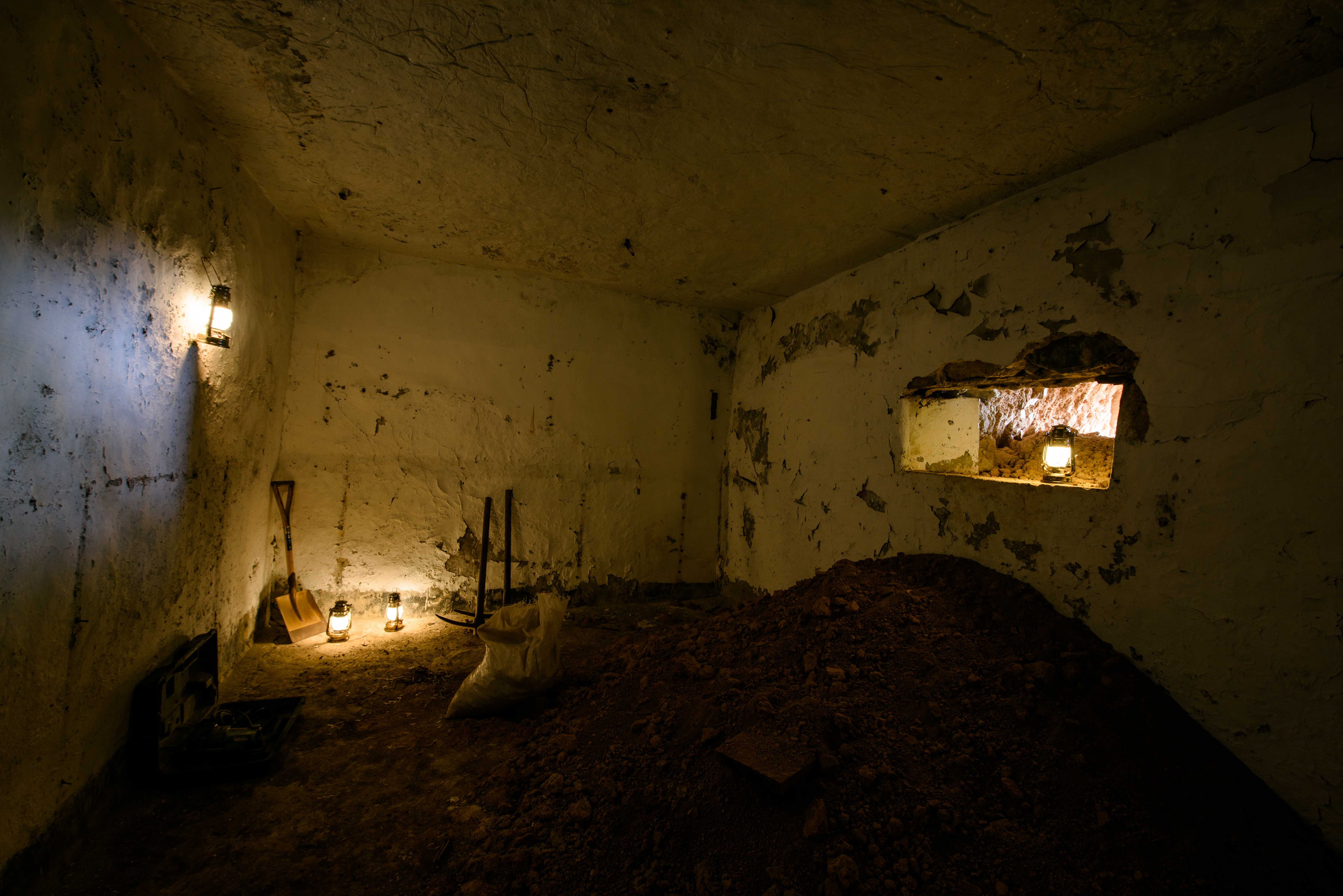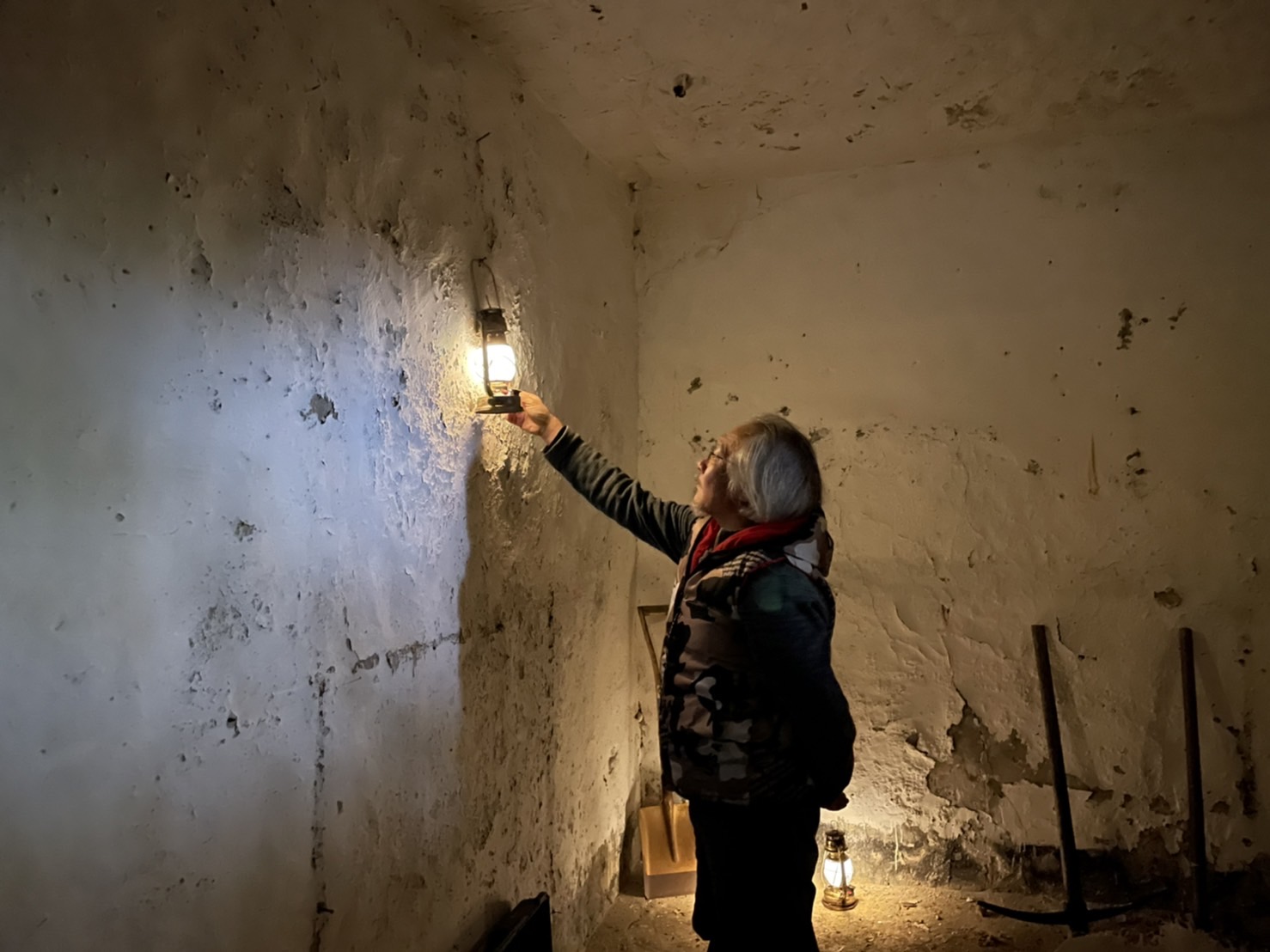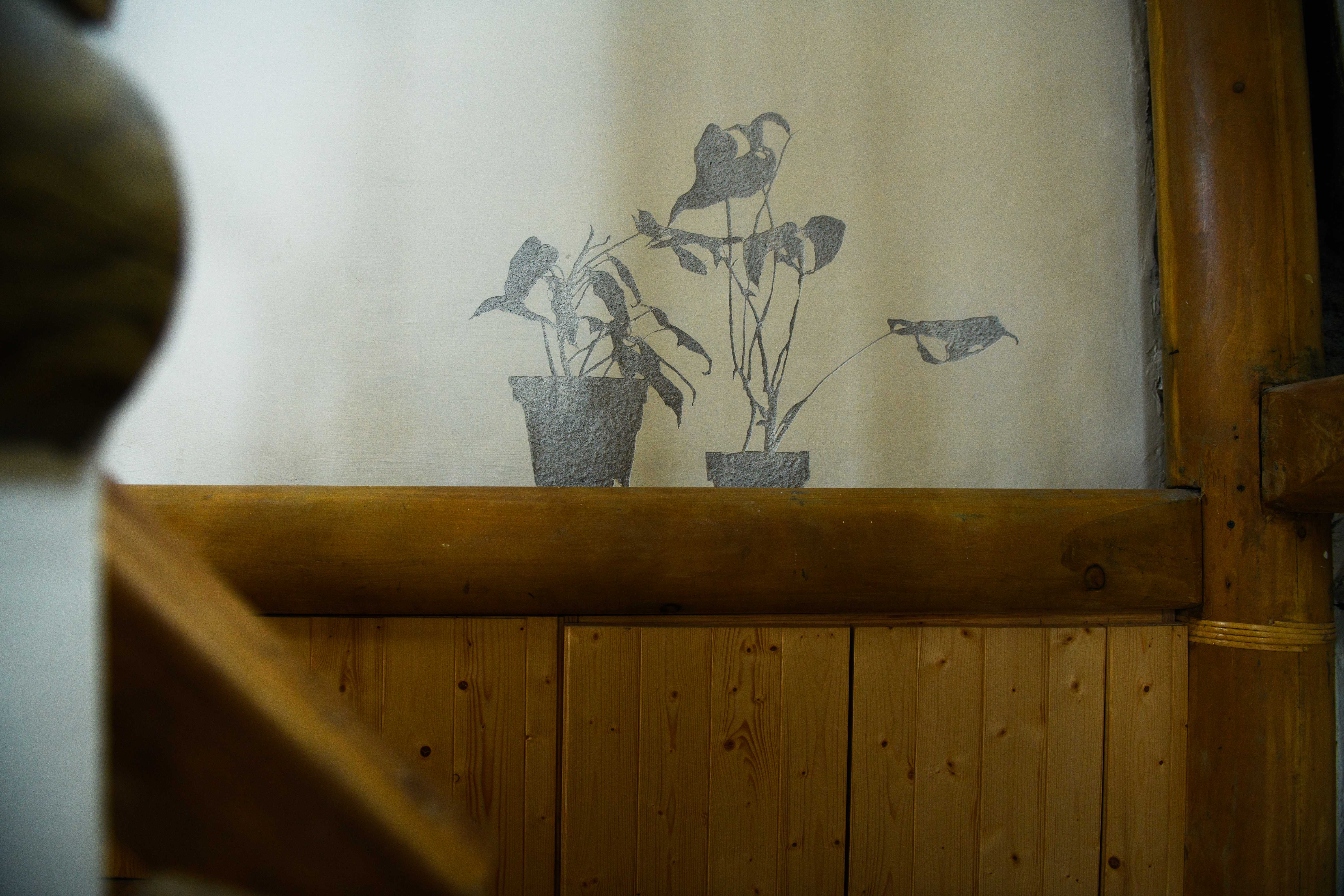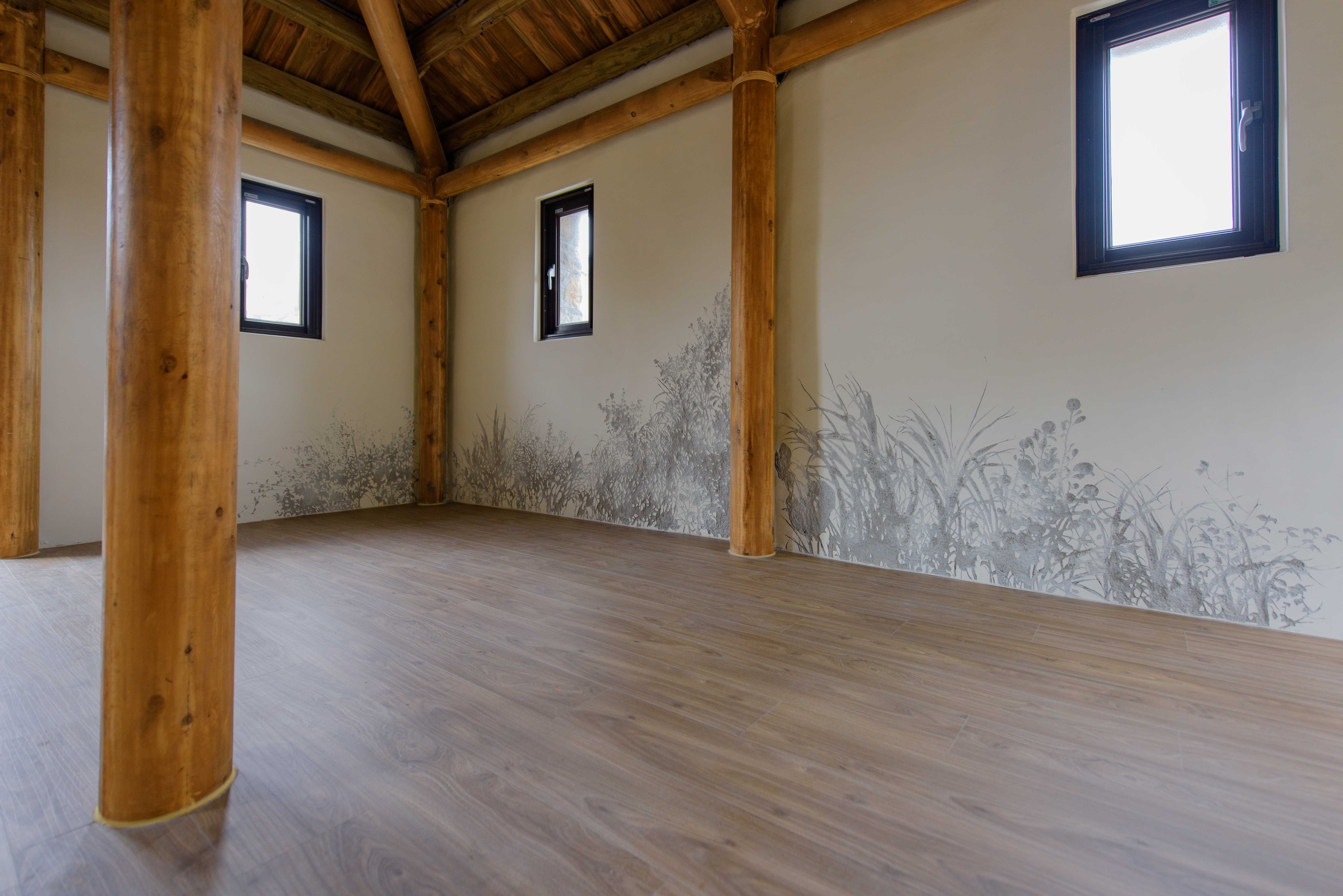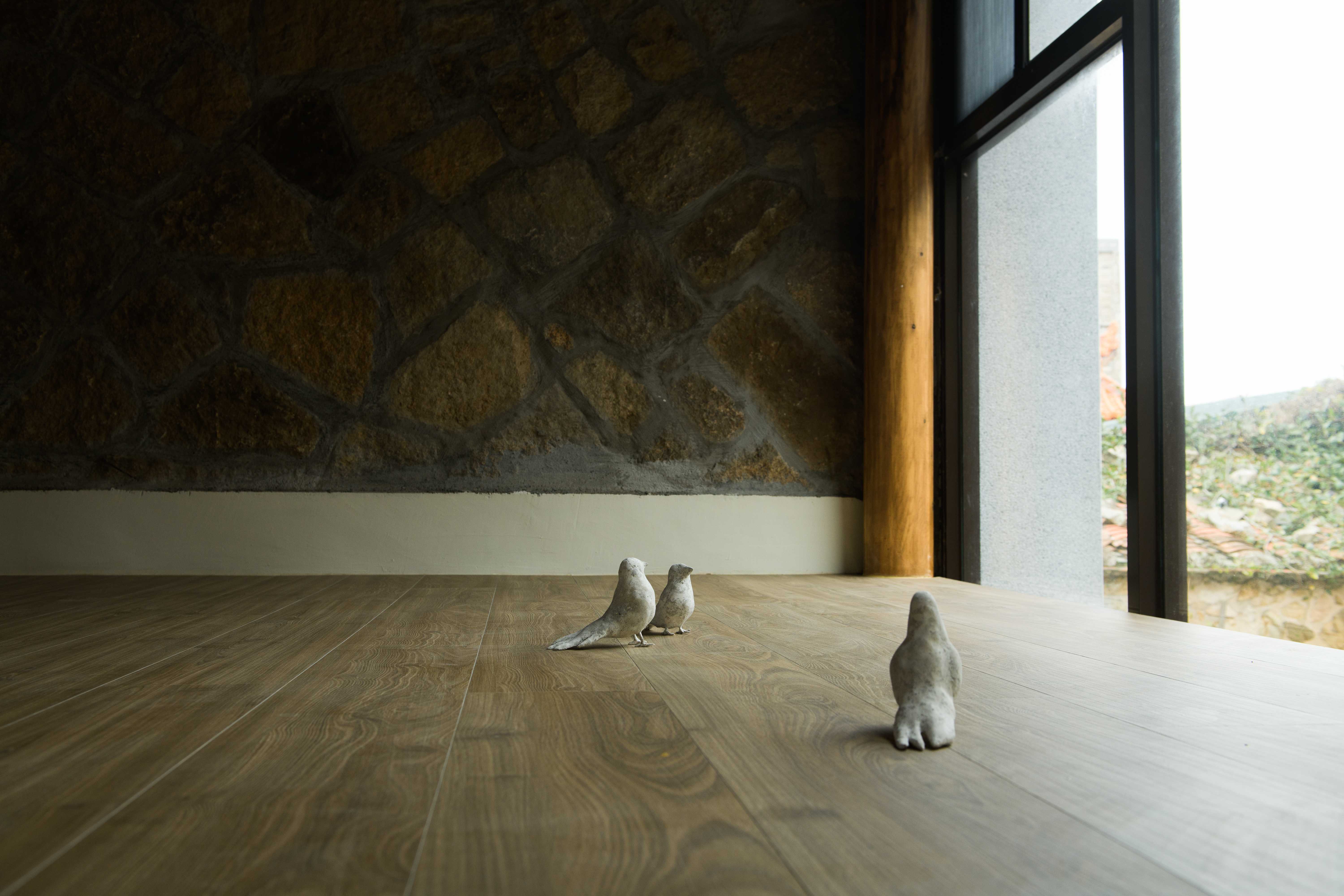作為馬祖主要的藝術家與文化行動者,曹楷智致力於在地藝文發展與深耕美術教學。進駐七七據點後,日以繼夜親身將廢棄坑道轉譯為藝術家工作室與交流空間,更不忘將自身創作的能量投入於在地發展的理想性。坑道地面以工作狀態呈現其藝術創作的軌跡,坑道地下除保留原有的戰地遺跡,呈現出藝術家透過身體銘刻不可見的勞動,更象徵著那些被隱匿在地下的軼聞故事。
The surface of the tunnel presents the trajectory of Tsao’s artistic creation in a working state while the underground of the tunnel preserves the original remnants of war, showing the artist’s unseen labor inscribed through his body and symbolizing the anecdotal stories that have been hidden.
曹楷智
1957年生於台灣馬祖島,曾赴西班牙馬德里學習,創作領域包括水墨、水彩、陶瓷彩繪、雕塑、及裝置藝術等。返國後長期蟄居馬祖,成為馬祖藝壇的代表性人物。
Born in 1957, Matsu Islands, Taiwan, Chao Kai-chih graduated from the National Taiwan Academy of Arts in 1998; He has been to Spain and studied. He works with a variety of mediums, such as Ink wash, watercolor, ceramic painting, sculpture and installation art. After returning to Taiwan, he resided in Matsu island and became a representative figure in the local art circle.
The surface of the tunnel presents the trajectory of Tsao’s artistic creation in a working state while the underground of the tunnel preserves the original remnants of war, showing the artist’s unseen labor inscribed through his body and symbolizing the anecdotal stories that have been hidden.
曹楷智
1957年生於台灣馬祖島,曾赴西班牙馬德里學習,創作領域包括水墨、水彩、陶瓷彩繪、雕塑、及裝置藝術等。返國後長期蟄居馬祖,成為馬祖藝壇的代表性人物。
Born in 1957, Matsu Islands, Taiwan, Chao Kai-chih graduated from the National Taiwan Academy of Arts in 1998; He has been to Spain and studied. He works with a variety of mediums, such as Ink wash, watercolor, ceramic painting, sculpture and installation art. After returning to Taiwan, he resided in Matsu island and became a representative figure in the local art circle.
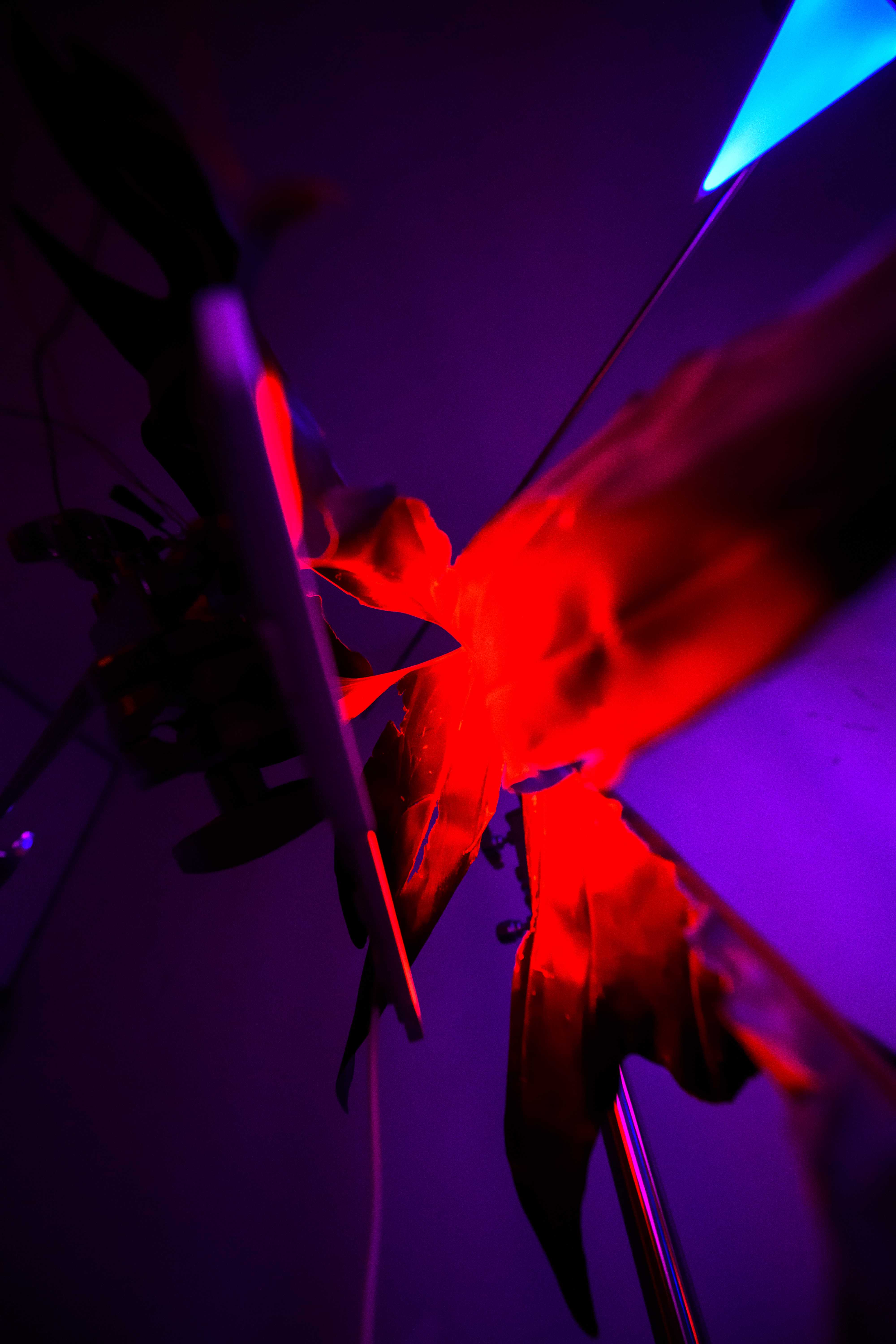
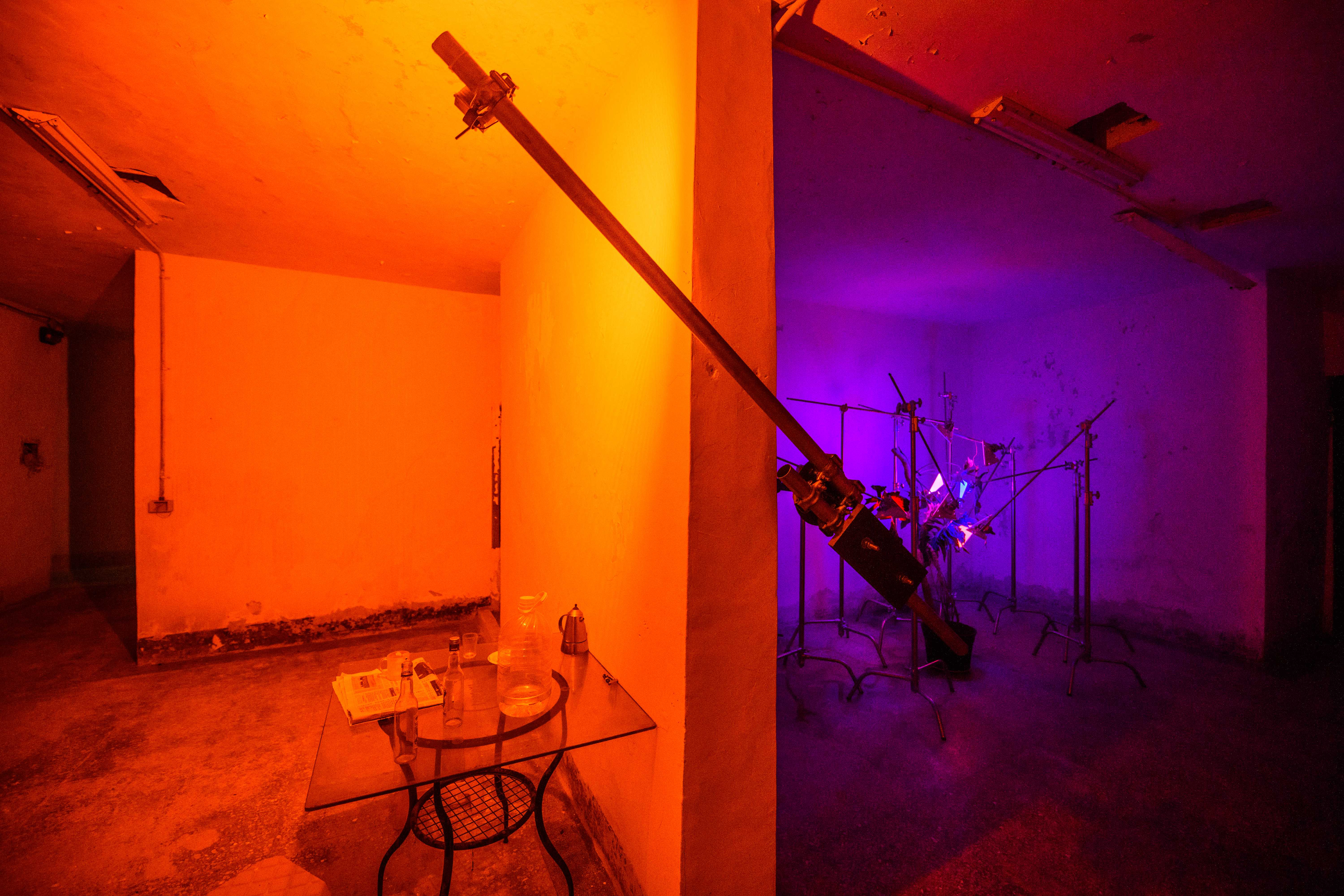
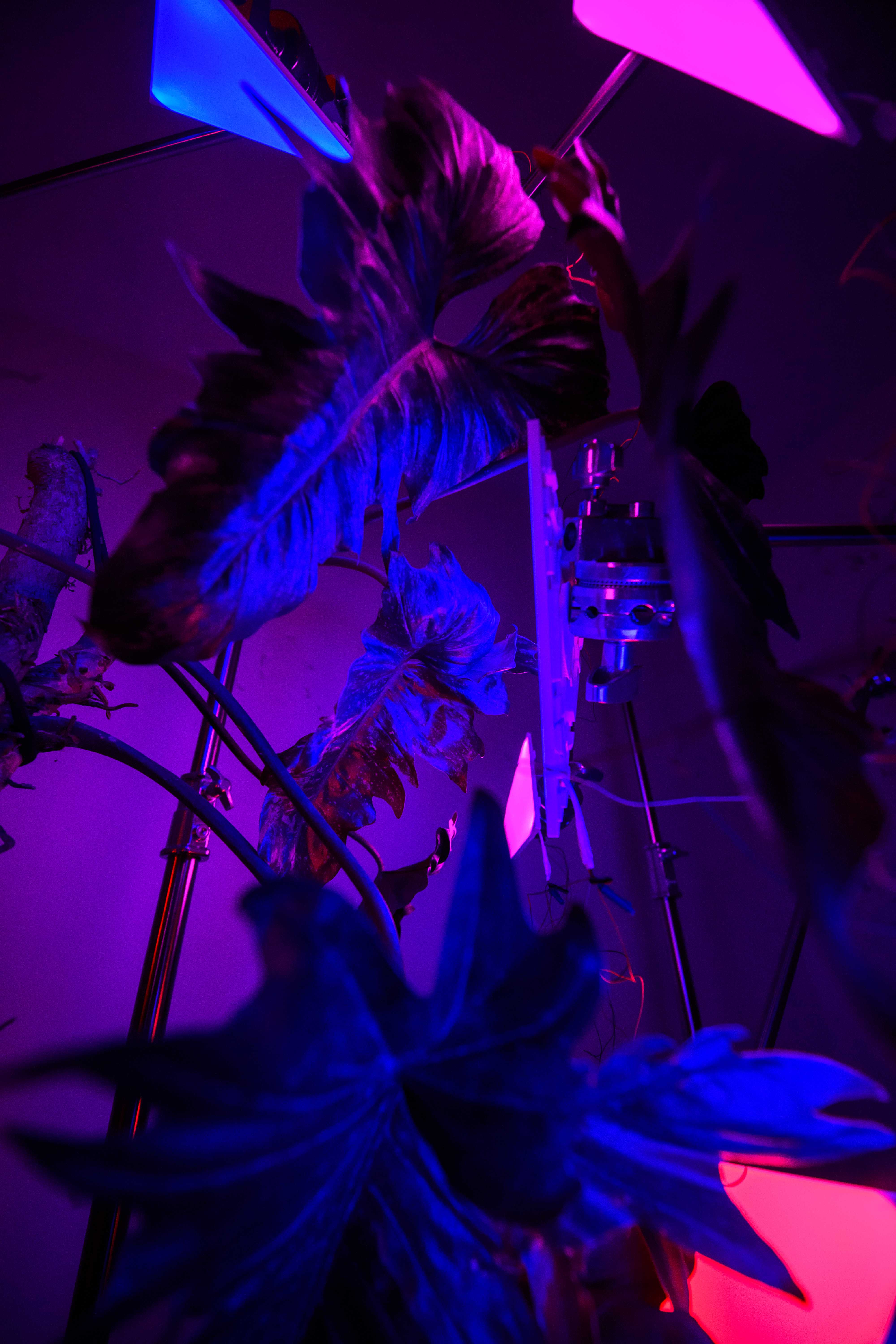
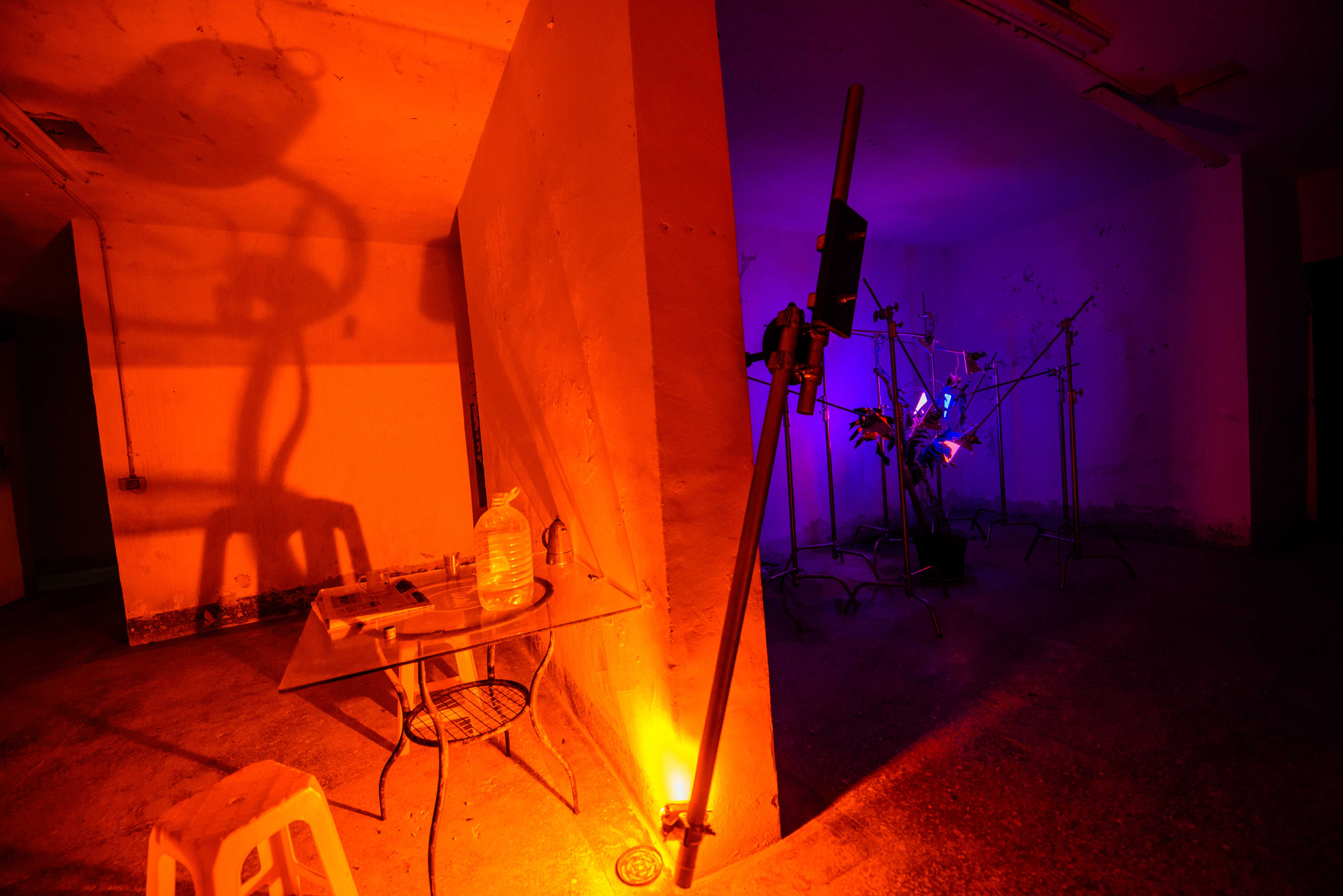
利安.摩根
照理來說 應該可行
鋼、馬達、燈、雲斑金龍蔓綠絨
南竿77據點
Liam MORGAN
In theory, it should be OK
Steel, motor, lights and Philodendron golden dragon
77 Stronghold
Liam MORGAN
In theory, it should be OK
Steel, motor, lights and Philodendron golden dragon
77 Stronghold
本作品探索了藝術家在過往創作中所關注的孤立、人造自然景象議題,及藝術家對台灣過去和現在的地緣政治處境的觀察,坑道是一處軍民在在此經歷長時間躲避未定義的危險,被視為一組未來,或替代現實的場景。本作品在地下坑道內設置植物,用人造光線與水源澆溉以維持其生命系統,隱喻過去戰事期間坑道內士兵的生存樣態,深探人類隔離之概念及身體對應內外空間的關係,透過移動行走與燈光裝置所產生的無意識敘事,開啟了身體之於地下空間的多元感受。
This work delves into the concept of human isolation and the relationship between the body and internal and external space. Through the unconscious narrative generated by walking and the lighting installation, it opens up the body’s diverse perceptions in the underground space.
利安.摩根
出生於加拿大聖約翰市的視覺藝術家與電影攝影師,利安以帶有介入與斷裂感的手法創作,作品往往具有干涉主義意味,並以光為主要媒介。 2002 年他於清邁大學開始接觸政治學、人類學與都市發展研究,並輾轉進入藝術領域。
Liam Morgan, born in Canada, is a visual artist and film-maker whose practice involves interference and disruption and his work is often interventionist in nature. Much of his work uses light as a medium. He came to his practice through an unusual path, passing political science, anthropology and development studies, bringing him to Chiang Mai University (Thailand) in 2002 and then to documentary film-making through Images Asia, an activist documentary-production group where he worked for a number of years.
This work delves into the concept of human isolation and the relationship between the body and internal and external space. Through the unconscious narrative generated by walking and the lighting installation, it opens up the body’s diverse perceptions in the underground space.
利安.摩根
出生於加拿大聖約翰市的視覺藝術家與電影攝影師,利安以帶有介入與斷裂感的手法創作,作品往往具有干涉主義意味,並以光為主要媒介。 2002 年他於清邁大學開始接觸政治學、人類學與都市發展研究,並輾轉進入藝術領域。
Liam Morgan, born in Canada, is a visual artist and film-maker whose practice involves interference and disruption and his work is often interventionist in nature. Much of his work uses light as a medium. He came to his practice through an unusual path, passing political science, anthropology and development studies, bringing him to Chiang Mai University (Thailand) in 2002 and then to documentary film-making through Images Asia, an activist documentary-production group where he worked for a number of years.

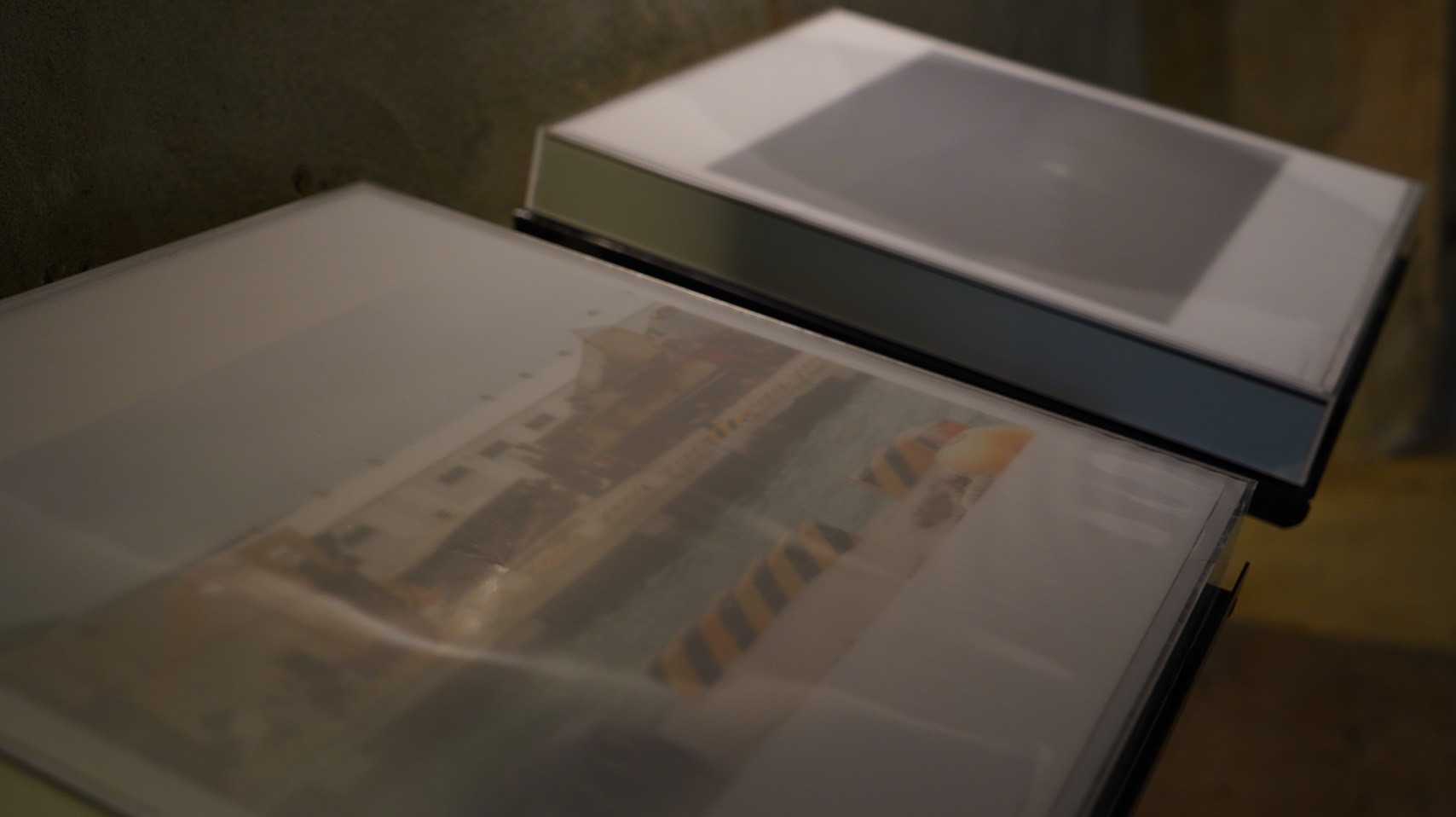
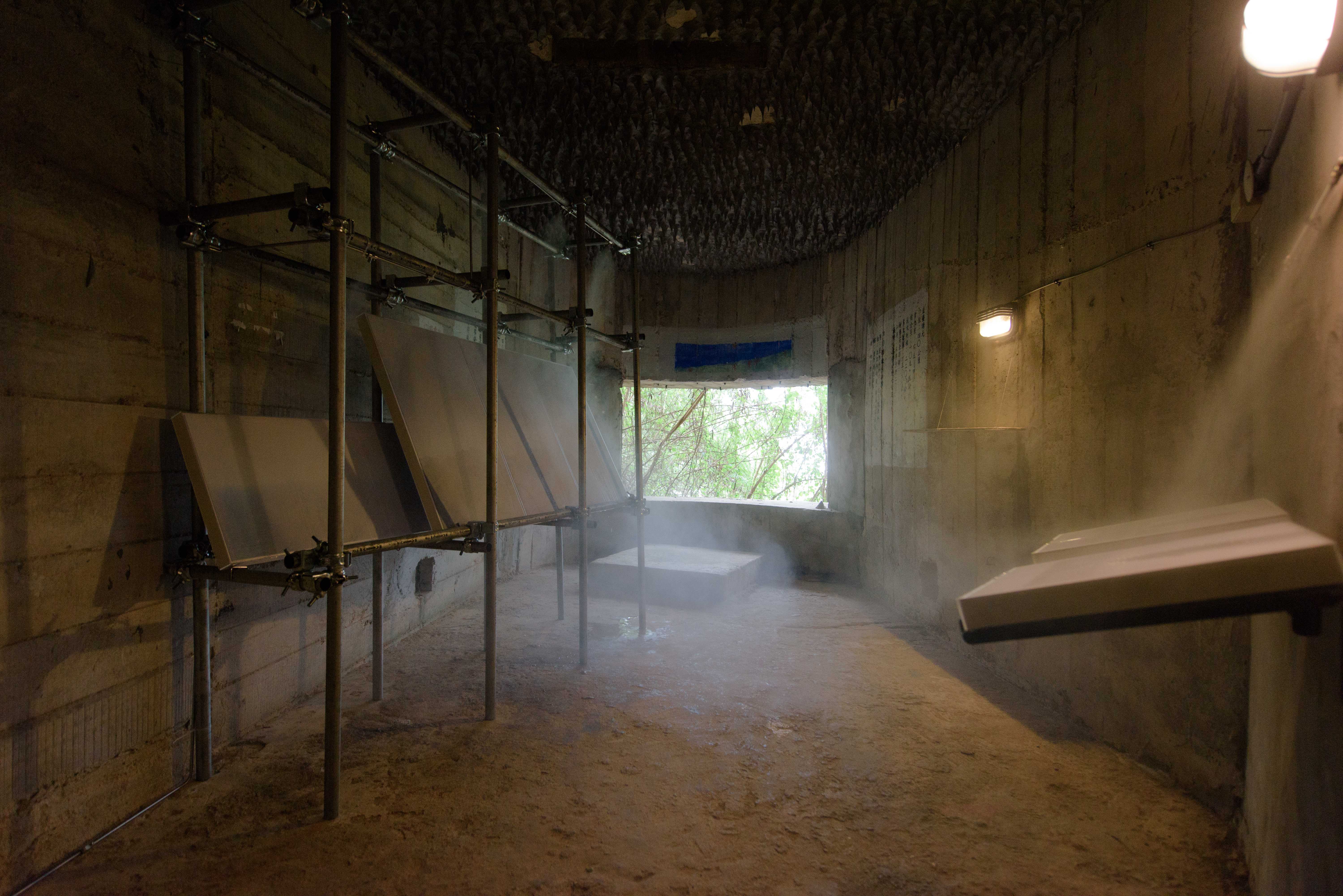
丁建中
靜候之景:馬祖列嶼
攝影、感濕油墨、壓克力、木頭、鐵件、水霧設備
DING Chien-Chung
The Elapse:Matsu
Photography, Hydrochromic Ink, Acrylic, Wood, Metal and Fog System
77 Stronghold
一年中有四分之一的日子,馬祖列嶼浸潤在霧裡。這段日子,馬祖居民眼中的四周與遠方,都透著一層潮濕的濾鏡。本裝置以乳白感濕油墨印刷之平面攝影,透過裝置反覆以水霧浸濕。於馬祖列嶼幾處角落在不同時間望向海面所採集的影像,隨濕氣浮現又消散。或許岩岸節理、或許廢棄的戰備道,或許望向抽砂船包圍的海面、或許望向島與島間...。作品旁側的坑道射擊窗外,腥鹹海風浮聚再消散,伴隨裝置影像一同迴盪著往復循環的潮濕記憶。
In this installation, creamy, moisture-sensitive photographic prints are repeatedly soaked in the mist, and those images of sea views—captured from different angles at different times and in various locations on the islands—merge and disappear along with the mist, whether depicting the patterns of rocks, abandoned road bases, the sea surrounded by sand pump dredgers, or simply a view between the islands.
丁建中
近期作品嘗試將原先的機械性消減,純粹的去回應所處空間下的自然狀態,並將原先對光的處理,擴張出包含對溫度、濕度、觸覺、動能中,與觀者自身的身體、記憶之關係,其作品常於台灣與國外各地展出並獲獎。
DING Chien-Chung attempts to withdraw the machinery in his recent works, echoing the natural state of the involving space. Also, he extends the interpretation of light to the relationship between the viewer’s body and memory. His works were exhibited in Taiwan and around the world.
In this installation, creamy, moisture-sensitive photographic prints are repeatedly soaked in the mist, and those images of sea views—captured from different angles at different times and in various locations on the islands—merge and disappear along with the mist, whether depicting the patterns of rocks, abandoned road bases, the sea surrounded by sand pump dredgers, or simply a view between the islands.
丁建中
近期作品嘗試將原先的機械性消減,純粹的去回應所處空間下的自然狀態,並將原先對光的處理,擴張出包含對溫度、濕度、觸覺、動能中,與觀者自身的身體、記憶之關係,其作品常於台灣與國外各地展出並獲獎。
DING Chien-Chung attempts to withdraw the machinery in his recent works, echoing the natural state of the involving space. Also, he extends the interpretation of light to the relationship between the viewer’s body and memory. His works were exhibited in Taiwan and around the world.
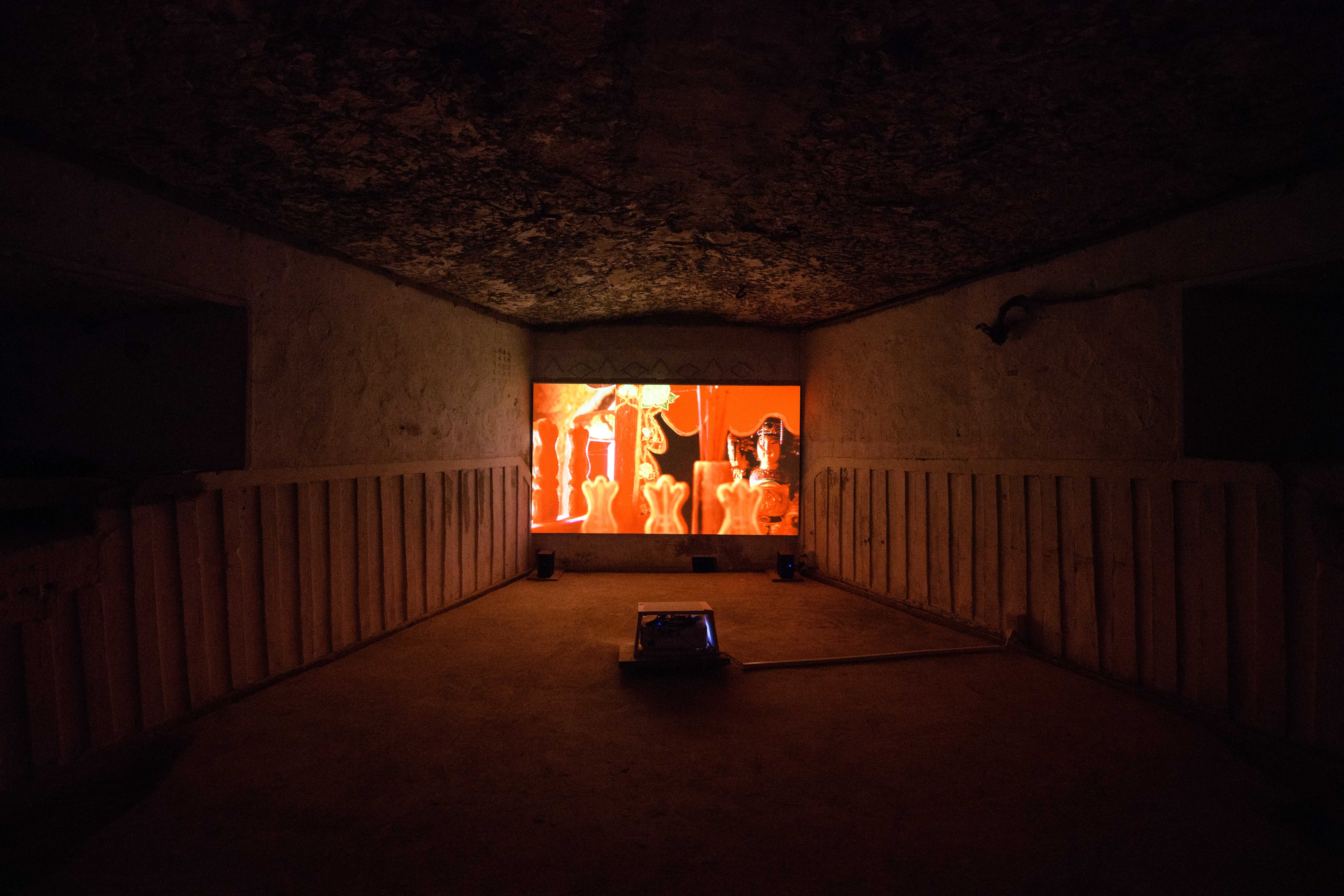

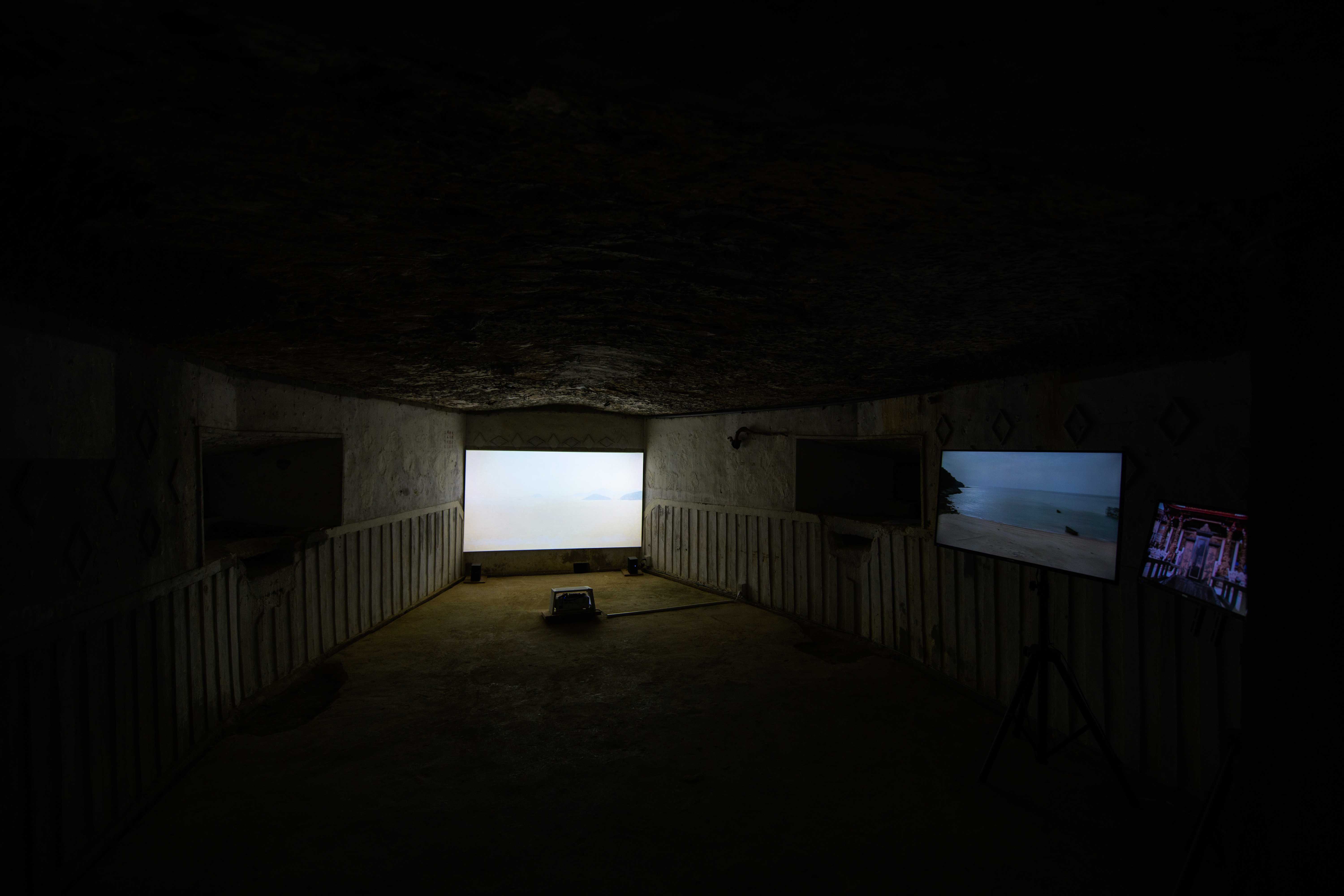
陳飛豪
水流之神
單頻道錄像、雙頻道錄像
CHEN Fei-Hao
God flowing in the water
Single-channel video, Two-channel video
77 Stronghold
馬祖作為由多個島嶼組成的生活共同體,與海洋或者說與「水」的關係極為密切,其中關於「水流屍成神」的有應公信仰,即早期漁民發現遇海難的浮屍,會撈捕上岸並且妥善處理進行安葬,隨著神蹟的出現,會從水流屍轉化成為地方鄉土神,在馬祖最具代表為西莒威武陳元帥,以及南竿的梅石高總管、福澳林大姐、北竿的楊公八使等等,連香火最盛的媽祖信仰也在此沾染了近似的色彩,本作則透過檔案影片、自撰文字與記錄性影像等結合影像裝置形式,探索該風俗背後的文化想像與在地意識。
This work explores the cultural imagination and local consciousness behind the custom of transforming drowned corpses into gods in Matsu through a combination of archival film, self-authored text, and documentary videos combined with video installations.
陳飛豪
擅長文字寫作並運用觀念式的攝影與動態影像詮釋歷史文化與社會變遷所衍生出的各種議題,也將影像與各種媒介如裝置、錄像與文學作品等等結合,探討不同媒介間交匯結合後所產生的各種可能性。
Chen Fei-hao, is clever at writing and resorting to conceptual photography and moving images to interpret various issues associated with history and culture as well as social changes, and he also combines images with such media as installations, videos, and literature to probe into the possibilities of the convergence among different media.
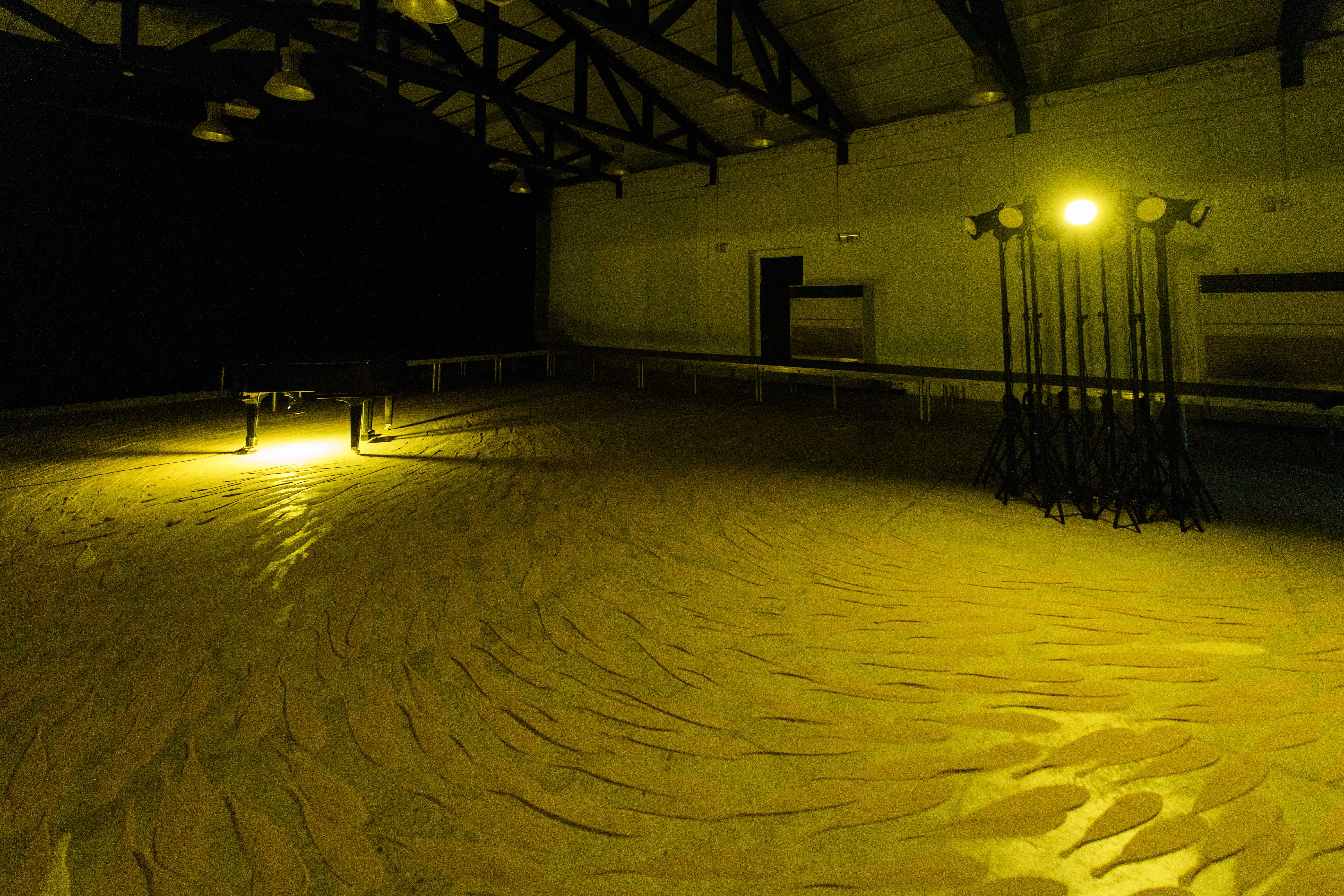

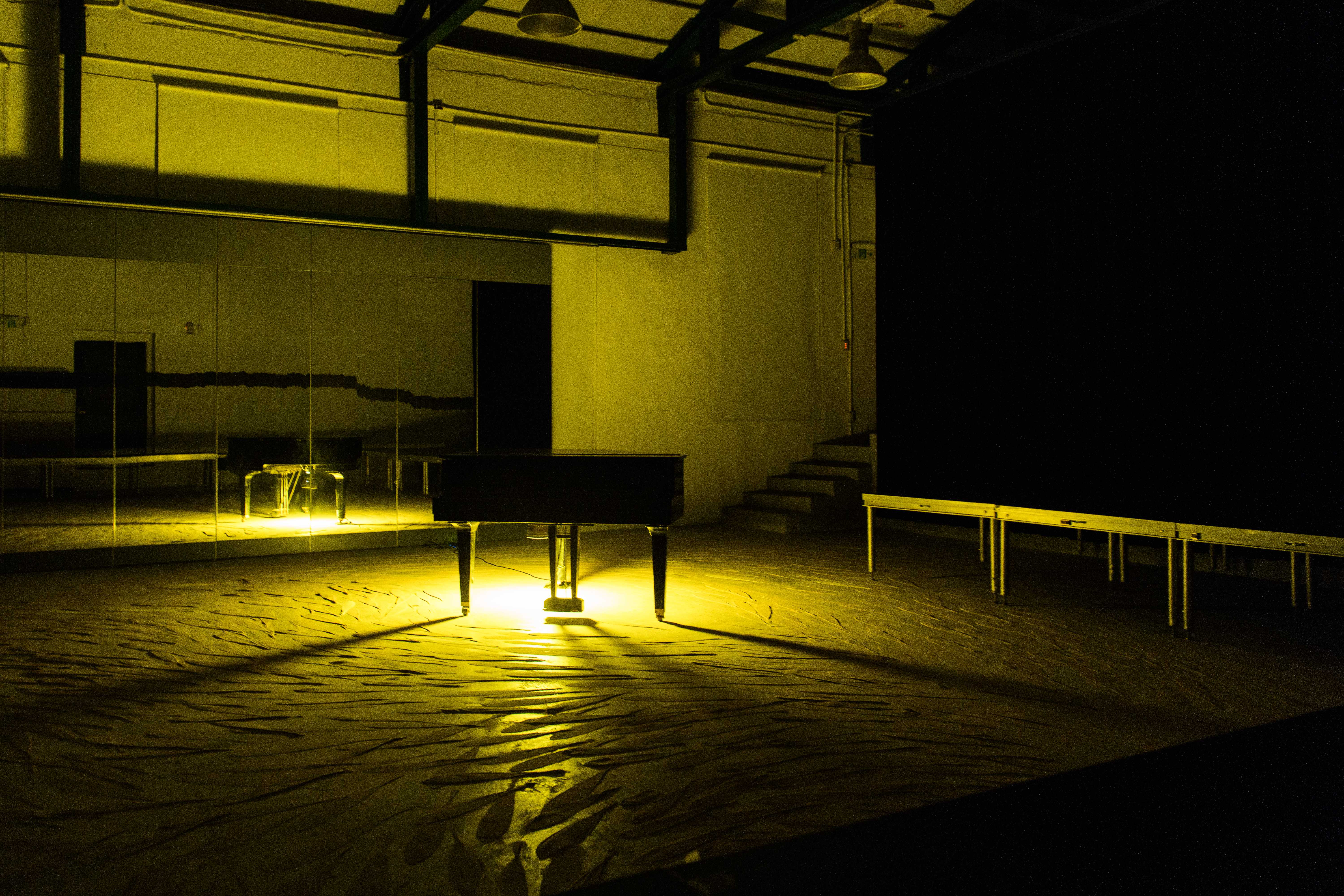
劉致宏
漁火
沙、LED燈具、閃爍程式控制器、複合媒材
南竿山隴排練場
LIU Chih-hung
Chorous
Sand, LED light, Flashcontroller, Multi-media
馬祖四鄉五島因地理位置與海洋資源條件,過去漁業產能豐沛,春分到穀雨清明之際是黃魚洄游東引海域產卵的時機,作品《漁火Chorous》圍繞在早期漁民「聽音辨位」尋找魚群的特殊漁業文化,此次創作邀請盧森堡籍海洋科學研究員Sven Gastauer加入協作,以紐澳與大西洋等海洋聲納探測研究 (acoustic susceptance) 對照舟山群島、馬祖東引橫山等地聽音辨位文化,同時結合燈塔頻率與明滅間隔的模擬,再現東引與東莒兩座燈塔的白聯閃光,跨越物理距離相互發送訊號、述說對話與馬祖故事。
Chorous evokes how early fishers found fish by “listening”to their locations and simulates the flashing frequency of the lighthouses at Dongyin and Dongju, reinterpreting their transmission of signals across a physical distance as though they are communicating and telling the stories of Matsu.
劉致宏
近年的繪畫創作持續關注在生命的體認與生活經驗的捕捉,用日常的角度編構敘事並賦予詮釋。創作類型涵括了繪畫、裝置、影像、現成物、訪查檔案、印刷出版物等,並聚焦討論在「拾得/材料/能動性」、「語言形式的轉化」與「在地關係連結」 等面向。
Liu Chih-Hung recent painting practice distills everyday experiences into a personal understanding of life where ordinary narratives are told with a nuanced perspective, while emotions and images coalesce in his work. He straddles across a wide range of mediums, such as painting, installation, moving image, found objects, and print publications.
Chorous evokes how early fishers found fish by “listening”to their locations and simulates the flashing frequency of the lighthouses at Dongyin and Dongju, reinterpreting their transmission of signals across a physical distance as though they are communicating and telling the stories of Matsu.
劉致宏
近年的繪畫創作持續關注在生命的體認與生活經驗的捕捉,用日常的角度編構敘事並賦予詮釋。創作類型涵括了繪畫、裝置、影像、現成物、訪查檔案、印刷出版物等,並聚焦討論在「拾得/材料/能動性」、「語言形式的轉化」與「在地關係連結」 等面向。
Liu Chih-Hung recent painting practice distills everyday experiences into a personal understanding of life where ordinary narratives are told with a nuanced perspective, while emotions and images coalesce in his work. He straddles across a wide range of mediums, such as painting, installation, moving image, found objects, and print publications.
「採光」原指因為都市化及工業化之後,重新挖開被埋藏在地底深處的遺留建物,讓地底下的溝渠或水道重見天日。藝術家將此概念轉化對於空間的處理,進行一場歷史與美學造型之間,將時間軌跡拉出的考古挖掘工程。以地下軍事設施的室內窗景為依據,重新將窗外的植物風景為構圖雕鑿在空間的牆面上。藉由雕鑿毀壞原本的物理空間,同時重建出過去某個日常片刻的輪廓,藉此疊合跨時的印記,將不同時空脈絡的物質、光影與角落,相互成為彼此共生的形體,創造出一處另類的歷史風景。
By destroying the original physical space and reconstructing the outline of the past, this carving overlaps the imprints of time and space, turning materials, lighting, and corners of different times and spaces into symbiotic forms, creating an alternative historical landscape.
邱承宏
其創作多以裝置、雕塑的方式呈現,就像是進行一場考古探險般,他善於挖掘生存時空曾經存在的身影與軌跡,並透過抽象的手法重新演繹那些被合理化及設計過的邏輯規則,將它們生動地重塑,藉此發展出一套巨大的記憶修補術。
CHIU Chen-Hung works are primarily presented in the framework of installation and sculpture. Like conducting an archeological expedition, he is especially proficient in excavating remaining outlines and imprints from bygone time and space. Through his practice of abstraction and reinterpreting both designed and rationalized logics, he vividly reshapes these existed objects and thus develop a vast memory restoration.
By destroying the original physical space and reconstructing the outline of the past, this carving overlaps the imprints of time and space, turning materials, lighting, and corners of different times and spaces into symbiotic forms, creating an alternative historical landscape.
邱承宏
其創作多以裝置、雕塑的方式呈現,就像是進行一場考古探險般,他善於挖掘生存時空曾經存在的身影與軌跡,並透過抽象的手法重新演繹那些被合理化及設計過的邏輯規則,將它們生動地重塑,藉此發展出一套巨大的記憶修補術。
CHIU Chen-Hung works are primarily presented in the framework of installation and sculpture. Like conducting an archeological expedition, he is especially proficient in excavating remaining outlines and imprints from bygone time and space. Through his practice of abstraction and reinterpreting both designed and rationalized logics, he vividly reshapes these existed objects and thus develop a vast memory restoration.


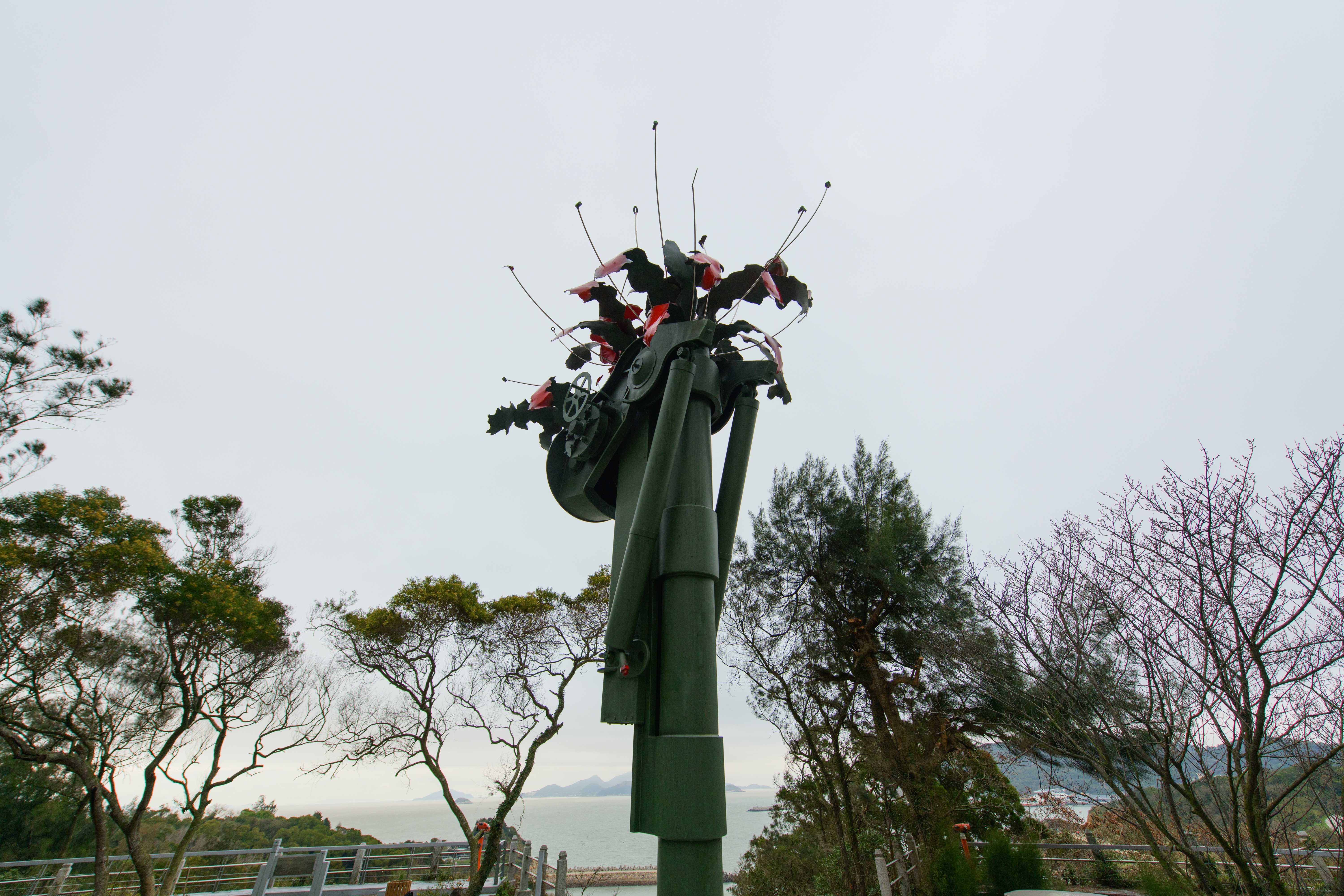
廖建忠
珠螺花開時,
不鏽鋼、工業塗料
LIAO Chien-Chung
Zhuluo in Blossom
Stainless steel, Industrial Coatings
馬祖不僅為東亞區生物分布的樞紐地帶,更是古往今來商船貿易進出福州必停留之處,珠螺村是島上少有的農業區域,因戰務改寫了村落的際遇,原有的常民生活也伴隨潛藏於花崗岩鑿的坑道之下。列島上稀有的原生種植物紅花石蒜,別名為「彼岸花」也是馬祖的縣花。藝術家仿生榴彈砲砲管轉化為枝幹,頂上開散花葉相見的紅花,象徵卸下前線使命後持續綻放嶄新的未來意象,在過往與未來、山風與海景聚合之處,綿延著過往的思念轉身眺望不再失落的故鄉。 "
Liao conceives the howirzer gun as a branch that blossoms with red flowers that do not wither at a place where the past and future, mountain breeze and seascape converge, symbolizing the ambiguous history of the island and the multifaceted Matsu imagery that continues to blossom after the war.
廖建忠
作品遊走於擬仿物與真實物之間的模糊曖昧,觀者從稀鬆平常的觀看中信以為真,到察覺受騙而驚呼,此過程正是藝術家企圖透過物件的模仿再現,刺激人們審視習以為常的環境,喚出被模仿物件背後所指涉的個人生命敘事,並帶出各項社會關注。
Liao Chien-Chung his work explores the ambiguous relationship between the simulations and the real objects. From taking the works for what they might be to finding out the deception, the audience experiences a process that the artist aims to offer through the representation of the objects. He hopes to stimulate people to inspect the environment they have taken for granted and to talk about the life stories behind these simulated objects as well as their social implications.
Liao conceives the howirzer gun as a branch that blossoms with red flowers that do not wither at a place where the past and future, mountain breeze and seascape converge, symbolizing the ambiguous history of the island and the multifaceted Matsu imagery that continues to blossom after the war.
廖建忠
作品遊走於擬仿物與真實物之間的模糊曖昧,觀者從稀鬆平常的觀看中信以為真,到察覺受騙而驚呼,此過程正是藝術家企圖透過物件的模仿再現,刺激人們審視習以為常的環境,喚出被模仿物件背後所指涉的個人生命敘事,並帶出各項社會關注。
Liao Chien-Chung his work explores the ambiguous relationship between the simulations and the real objects. From taking the works for what they might be to finding out the deception, the audience experiences a process that the artist aims to offer through the representation of the objects. He hopes to stimulate people to inspect the environment they have taken for granted and to talk about the life stories behind these simulated objects as well as their social implications.
